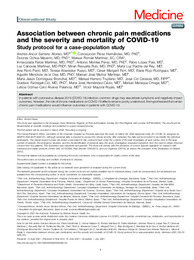Please use this identifier to cite or link to this item:
https://hdl.handle.net/11000/32335Full metadata record
| DC Field | Value | Language |
|---|---|---|
| dc.contributor.author | Serrano Afonso, Ancor | - |
| dc.contributor.author | Pérez hernández, Concepción | - |
| dc.contributor.author | Ochoa Mazarro, Dolores | - |
| dc.contributor.author | Román Martínez, Manuel | - |
| dc.contributor.author | Failde Martínez, Inmaculada | - |
| dc.contributor.author | Montes Pérez, Antonio | - |
| dc.contributor.author | López Pais, Pablo | - |
| dc.contributor.author | Cánovas Martínez, Luz | - |
| dc.contributor.author | Revuelta Rizo, Miren | - |
| dc.contributor.author | Padilla del Rey, María Luz | - |
| dc.contributor.author | Peiró, Ana | - |
| dc.contributor.author | Aberasturi Fueyo, Teresa | - |
| dc.contributor.author | Margarit Ferrí, César | - |
| dc.contributor.author | Rojo Rodríguez, Elena | - |
| dc.contributor.author | Mendiola de la Osa, Agustín | - |
| dc.contributor.author | Muñoz Martinez, Manuel José | - |
| dc.contributor.author | Domínguez Bronchal, María Jesús | - |
| dc.contributor.author | Herrero Trujillano, Manuel | - |
| dc.contributor.author | Cid Calzada, José | - |
| dc.contributor.author | Fabregat-Cid, Gustavo | - |
| dc.contributor.author | Hernández-Cádiz, María José | - |
| dc.contributor.author | Mareque Ortega, Manuel | - |
| dc.contributor.author | Gómez-Caro Álvarez Palencia, Leticia | - |
| dc.contributor.author | Mayoral Rojals, Víctor | - |
| dc.contributor.other | Departamentos de la UMH::Farmacología, Pediatría y Química Orgánica | es_ES |
| dc.date.accessioned | 2024-06-25T09:04:59Z | - |
| dc.date.available | 2024-06-25T09:04:59Z | - |
| dc.date.created | 2021-07 | - |
| dc.identifier.citation | Medicine Volume 100, Issue 30, Pages e26725 | es_ES |
| dc.identifier.issn | 0025-7974 | - |
| dc.identifier.uri | https://hdl.handle.net/11000/32335 | - |
| dc.description.abstract | In patients with coronavirus disease 2019 (COVID-19) infection, common drugs may exacerbate symptoms and negatively impact outcomes. However, the role of chronic medications on COVID-19 effects remains poorly understood. We hypothesized that certain chronic pain medications would influence outcomes in patients with COVID-19. The main aim is to assess the effect of these medications on the course of the disease in COVID-19 patients. Secondary aims are to compare disease severity and outcomes in patients with COVID-19 receiving chronic treatment with analgesics or other medications versus untreated patients and to determine prevalence of chronic pain medications in specific subgroups of hospitalized patients for COVID-19. Multicenter case-population study in 15 care centers for patients ≥18 years of age diagnosed and hospitalized with COVID-19. Controls will include patients treated at participating centers for chronic pain during the six-month period prior to March 15th, 2020. Each case will be age- and sex-matched to 10 controls. Patients will be grouped according to disease severity criteria. The primary outcome measures in patients admitted for COVID-19 will be: 1. statistical association between chronic pain medication and disease severity; 2.association between chronic pain treatment and survival. Secondary outcome measures include: 1.prevalence of chronic pain medications in patients with COVID-19 by age and sex; 2.prevalence of chronic pain medications in patients with COVID-19 vs controls. Patients and controls will be paired by age, sex, and geographic residence. Odds ratios with 95% confidence intervals will be calculated to determine the association between each drug and clinical status. Univariate and multivariate analyses will be performed. This is a study protocol. Data is actually being gathered and results are yet not achieved. There is no numerical data presented, so the conclusions cannot be considered solid at this point. Pain medications are likely to influence severity of COVID-19 and patient survival. Identifying those medications that are most closely associated with severe COVID-19 will provide clinicians with valuable data to guide treatment and reduce mortality rates and the long-term sequelae of the disease. | es_ES |
| dc.format | application/pdf | es_ES |
| dc.format.extent | 7 | es_ES |
| dc.language.iso | eng | es_ES |
| dc.publisher | NLM (Medline) | es_ES |
| dc.rights | info:eu-repo/semantics/openAccess | es_ES |
| dc.rights.uri | http://creativecommons.org/licenses/by-nc-nd/4.0/ | * |
| dc.subject | analgesics | es_ES |
| dc.subject | chronic pain | es_ES |
| dc.subject | coronavirus disease 2019 | es_ES |
| dc.subject | glucocorticoids | es_ES |
| dc.subject | non-steroidal anti-inflammatory drugs | es_ES |
| dc.subject | opioids | es_ES |
| dc.subject.other | CDU::6 - Ciencias aplicadas::61 - Medicina::615 - Farmacología. Terapéutica. Toxicología. Radiología | es_ES |
| dc.title | Association between chronic pain medications and the severity and mortality of COVID-19: Study protocol for a case-population study | es_ES |
| dc.type | info:eu-repo/semantics/article | es_ES |
| dc.relation.publisherversion | https://doi.org/10.1097/MD.0000000000026725 | es_ES |

View/Open:
Association between chronic pain medications.pdf
239,07 kB
Adobe PDF
Share:
.png)
